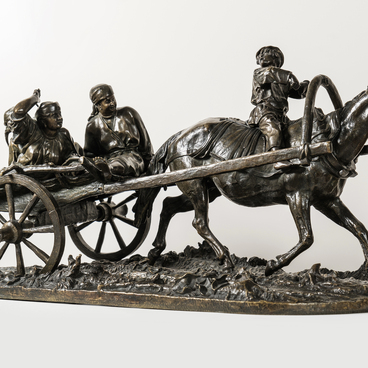This is a waist-length image of Emperor Peter III against a dark, neutral background. He is shown wearing a green caftan with a trimmed collar, cuffs, and passementerie with the Order of St. Andrew the Apostle the First-Called. There is also the Order of St. Anna on his chest. Under the uniform, he wears a silver cuirass. On his head, there is a periwig. Peter has an oval face, a high forehead, a straight nose, a small mouth with scarlet lips, and dark eyes looking directly at the viewer. His body is slightly turned toward the left shoulder with his right hand on his waist. Light plays an important role in this portrait. The emperor’s right hand is gently illuminated, with the thumb pointing to the glimmering order of St. Anna. His face is brightly lit. Half-smiling in a manner typical of a high society representative and gazing directly at the viewer, he has a somewhat mysterious expression on his face. The outlines of the emperor’s figure fade away against the dark background.
Peter III, Emperor of Russia, was born in Germany as Charles Peter Ulrich of Schleswig-Holstein-Gottorp. As he was the great-nephew of Charles XII of Sweden on his father’s side, Peter was initially seen as the potential heir to the Swedish throne. However, he was also the nephew of Empress Elizabeth of Russia who wanted to secure the throne for her family. In 1741, Elizabeth ordered to bring Charles Peter to the Russian Empire. He arrived in St. Petersburg a year later, traveling incognito under the name Count Dücker. Soon, the future Russian Emperor converted from Lutheranism to Orthodoxy. One of the most significant documents issued by Peter III was the “Manifesto on the Emancipation of the Nobility”, making the Russian nobility a privileged social class.
Peter also made some other major decisions. For example, he abolished the secret police, launched the annexation of church property, promoted commercial and industrial activities by establishing the first state bank and issuing banknotes, and adopted a decree on freedom of foreign trade. He also stopped the persecution of the Old Believers. It is believed that Peter III intended to reform the Russian Orthodox Church according to the Protestant model.
After the death of Empress Elizabeth on December
25, 1761, Peter was proclaimed Emperor of Russia. However, he ruled for only
186 days, as he was overthrown by his wife, Catherine the Great.


